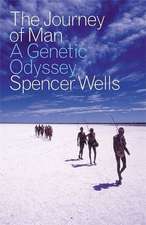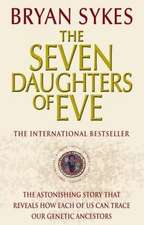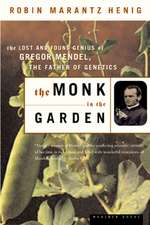One Hundred Years of Chromosome Research and What Remains to be Learned
Autor A. Lima-de-Fariaen Limba Engleză Paperback – dec 2010
Emphasis is placed on what remains to be learned, particularly in light of reality of the sequencing of DNA which leaves the previous era of chromosome research as a prehistoric event. It is at this turning point, that well formulated questions can be asked about many of the chromosome's properties, which remain to be unveiled.
The author, Lima-de-Faria is Professor Emeritus of Molecular Cytogenetics at Lund Unviersity, Sweden, previously Head of the Institute of Molecular Cytogenetics, Lund University.
| Toate formatele și edițiile | Preț | Express |
|---|---|---|
| Paperback (1) | 948.16 lei 6-8 săpt. | |
| SPRINGER NETHERLANDS – dec 2010 | 948.16 lei 6-8 săpt. | |
| Hardback (1) | 812.86 lei 39-44 zile | |
| SPRINGER NETHERLANDS – 31 iul 2003 | 812.86 lei 39-44 zile |
Preț: 948.16 lei
Preț vechi: 1156.29 lei
-18% Nou
Puncte Express: 1422
Preț estimativ în valută:
181.44€ • 187.46$ • 150.93£
181.44€ • 187.46$ • 150.93£
Carte tipărită la comandă
Livrare economică 20 martie-03 aprilie
Preluare comenzi: 021 569.72.76
Specificații
ISBN-13: 9789048163502
ISBN-10: 9048163501
Pagini: 228
Ilustrații: VII, 219 p. 549 illus.
Dimensiuni: 210 x 297 x 12 mm
Greutate: 0.52 kg
Ediția:Softcover reprint of hardcover 1st ed. 2003
Editura: SPRINGER NETHERLANDS
Colecția Springer
Locul publicării:Dordrecht, Netherlands
ISBN-10: 9048163501
Pagini: 228
Ilustrații: VII, 219 p. 549 illus.
Dimensiuni: 210 x 297 x 12 mm
Greutate: 0.52 kg
Ediția:Softcover reprint of hardcover 1st ed. 2003
Editura: SPRINGER NETHERLANDS
Colecția Springer
Locul publicării:Dordrecht, Netherlands
Public țintă
ResearchCuprins
First Period 1795–1850 The precursors: Better microscopes allowed reaching the cell level.- Second Period 1850–1900 The pioneers: The discovery of the chromosome was a by-product of microbiology.- Third Period 1900–1930 The era of abstract genetics: Order in embryonic development led to the finding of order in inheritance.- Fourth Period 1930–1950 The impact of physics and chemistry on genetics: World War II encouraged the development of microbial genetics.- Fifth Period 1950–1970 Radioisotopes and electron microscopy became a most fruitful combination: Molecular biology received its main impulse from disciplines outside genetics.- Sixth Period 1970–1980 The mechanisms of cancer and of development were sought at the DNA level: Biotechnology emerged as a new field as genetics created its own weapons.- Seventh Period 1980–1990 Neurobiology reached the molecular level: Artificial chromosomes and gene therapy became a reality.- Eighth Period 1990–2001 The genome of humans and of other organisms was sequenced: The age of multilaboratory collaboration was established.- Ninth Period 2001–2010 The post-genome era: The task that lies ahead.- From staining methods to DNA sequencing.- Main stages in the discovery of the cell’s structure and function.- The nucleus versus the cytoplasm. Which was most important?.- The description of cell division: An impressive transformation was accompanied by directed cellular movements.- Meiosis was another unexpected property: The cell could reduce its chromosome number.- The maintenance of identity of the chromosome during interphase was accompanied by constancy and variability of pattern in different tissues.- The centromere: A Pandora’s box of unearthed properties.- The telomere: Not just a terminus station.- Thenucleolus organizer: Nothing in the cell is comparable to it.- Cytoskeleton: A disgusting artifact became an important cell edifice.- Nuclear envelope: The nucleus disclosed its outer structure.- Centriole: An enigmatic cell invention.- Endoplasmic reticulum and Golgi apparatus: The building of membranes permitted molecular reactions to occur in defined sequences.- Cell membrane and cell wall: The cell became an individualized entity.- Chromosomes of viruses: An early or a late form of chromosome?.- Chromosomes of bacteria: Nearly naked DNA could become independent.- Chromosomes of mitochondria: Intruders invaded the cell.- Chromosomes of chloroplasts: Additional genomes entered the cell.- Physico-chemical processes are antithetical.- Maintenance of organization: The protozoan versus the human chromosome.- Maintenance of the chromosome phenotype.- Maintenance of gene order.- Maintenance of function.- The periodicity of chromosome transformations.- Structural change.- Change of pattern.- Change in size.- Change in number.- Change in function.- The models.- What the models do not tell us.- Where did the chromosome come from?.- Where is the chromosome going?.- Bibliography: A list of selected books that have dealt with the chromosome during the period 1870–2001.- References: Cited works between 1990 and 2001.- Sources of Illustrations 195—.- Subject inde.- Author inded.
Recenzii
"An interesting and absolutely unique work."
(Bengt O. Bengtsson, Professor of Genetics, Lund University, Sweden)
"I highly recommend Professor Lima-de-Faria's book because I consider it a fantastic achievement and of great interest to a large audience."
(Professor Felix Mitelman, Editor-in-Chief of Genes, Chromosomes and Cancer) "Thank you very much for your excellent book! Its conciseness, beautiful illustration sand comprehensive bibliography and references make it an outstanding piece of work – perhaps one of the best on my table."
(Alexander S. Spirin, Professor of Biochemistry and Molecular Biology, Moscow University, Member of the Russian Academy of Sciences)
"I was delighted to hear from you and to receive a copy of your new book "One hundred years of chromosome Research". I have started reading it and do so with great interest and enjoyment as it gives a flavour of your own particular excitement on the field as well as being a valuable account of the major milestones in cytogenetics. I firmly believe that molecular biologists need an understanding of the nature and behaviour of chromosomes if they are to fully advance in their discipline. I believe that your book will give them the necessary direction. Hearty congratulations on the publication of this excellent work."
(Malcolm Ferguson-smith, Professor Emeritus of Pathology, Cambridge University, England)
"I have recently read with great interest your new book One hundred years of Chromosome Research . I learned about it (and bought myself a copy) at the American Society of Cell Biology annual meeting last month. I congratulate you on doing an excellent job of bringing together all the facets of the history of chromosome research and I am also honoured that you have included some of my work in the book."
(James R. Paulson, Professor of Chemistry, University of Wisconsin, USA)
"Thanks for the wonderful book! I’m almost finishedreading it. I very much appreciate how you let us know about all the loose ends and ignored paths."
(Dr. Richard Gordon, Health Sciences Centre, University of Manitoba, Canada)
"The book is a well-filled storehouse of interesting information, presumably gathered during a lifetime of research and teaching, a store on which the reader draws for his or her own benefit. For those somewhat familiar with chromosome, genetics or cell biology this book is rewarding reading. For younger colleagues in this field it should be considered obligatory."
(Professor Walther Trout, University of Lübeck, Germany)
"I always admire your brilliant work on chromosomes."
(Takashi Sugimura, President Emeritus, National Cancer Center, Tokyo, Japan)
"Many thanks for your beautiful book on chromosome research. I am sure I will enjoy reading it."
(Prof. Pierre Chambon, Unité Biologie Moleculaire, Faculté de Medicine, Universitè de Strasbourg, France)
(Bengt O. Bengtsson, Professor of Genetics, Lund University, Sweden)
"I highly recommend Professor Lima-de-Faria's book because I consider it a fantastic achievement and of great interest to a large audience."
(Professor Felix Mitelman, Editor-in-Chief of Genes, Chromosomes and Cancer) "Thank you very much for your excellent book! Its conciseness, beautiful illustration sand comprehensive bibliography and references make it an outstanding piece of work – perhaps one of the best on my table."
(Alexander S. Spirin, Professor of Biochemistry and Molecular Biology, Moscow University, Member of the Russian Academy of Sciences)
"I was delighted to hear from you and to receive a copy of your new book "One hundred years of chromosome Research". I have started reading it and do so with great interest and enjoyment as it gives a flavour of your own particular excitement on the field as well as being a valuable account of the major milestones in cytogenetics. I firmly believe that molecular biologists need an understanding of the nature and behaviour of chromosomes if they are to fully advance in their discipline. I believe that your book will give them the necessary direction. Hearty congratulations on the publication of this excellent work."
(Malcolm Ferguson-smith, Professor Emeritus of Pathology, Cambridge University, England)
"I have recently read with great interest your new book One hundred years of Chromosome Research . I learned about it (and bought myself a copy) at the American Society of Cell Biology annual meeting last month. I congratulate you on doing an excellent job of bringing together all the facets of the history of chromosome research and I am also honoured that you have included some of my work in the book."
(James R. Paulson, Professor of Chemistry, University of Wisconsin, USA)
"Thanks for the wonderful book! I’m almost finishedreading it. I very much appreciate how you let us know about all the loose ends and ignored paths."
(Dr. Richard Gordon, Health Sciences Centre, University of Manitoba, Canada)
"The book is a well-filled storehouse of interesting information, presumably gathered during a lifetime of research and teaching, a store on which the reader draws for his or her own benefit. For those somewhat familiar with chromosome, genetics or cell biology this book is rewarding reading. For younger colleagues in this field it should be considered obligatory."
(Professor Walther Trout, University of Lübeck, Germany)
"I always admire your brilliant work on chromosomes."
(Takashi Sugimura, President Emeritus, National Cancer Center, Tokyo, Japan)
"Many thanks for your beautiful book on chromosome research. I am sure I will enjoy reading it."
(Prof. Pierre Chambon, Unité Biologie Moleculaire, Faculté de Medicine, Universitè de Strasbourg, France)
Caracteristici
Is a unique work, no other book has covered the 100 years of Chromosome Research














